The main tasks of a fence in a private area or summer cottage are protection against intrusion and defining boundaries. When choosing a material and design features, the aesthetic component, harmony with the general architectural appearance, building codes are taken into account. What kind of fence to install is up to the owner himself, based on taste and practical needs.
Basic requirements for the construction of a fence

Requirements for fences are spelled out at the legislative level and regulated by local authorities. When erecting a fence between adjacent sections, it must be located strictly on the border. According to the standards, its height is no more than 1.5 m, the structure is transparent or mesh. Under an agreement with neighbors, which is confirmed by a notary, a higher structure can be installed. A blank fence with a height of more than 2 m can be installed from the side of the road and street. Any degree of translucency from 0 to 100% is allowed.
If the site is located in a suburban area, a building envelope construction permit is not required. In the city, the architectural appearance of the fence will have to be coordinated with the controlling organizations. When drawing up a drawing of a fence, take into account the standard distances from the house, outbuildings, trees. When installing a blind structure, it is important to leave gaps at the bottom to allow air movement. This option is not recommended for small areas; it shades the area.
When choosing support pillars, take into account the load of the spans material, the depth of soil freezing. Metal structures should not be less than 3 mm, otherwise they will bend. The gate supports are made more massive.
Before the construction of a heavy structure made of stone or brick, a study of the depth of the groundwater should be carried out. Information will be required when building a foundation.
Criteria for the selection of the enclosing structure
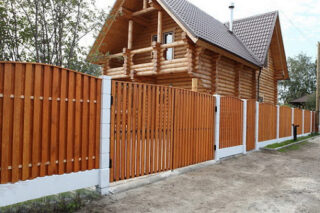
When choosing materials for the fence, they take into account the basic requirements for the structure:
- Strength and durability - the building is under stress from wind, precipitation, mechanical stress. She must withstand them for several years without repair.
- Protective function - the design must prevent people and animals from entering the private territory. Best of all, a solid fence made of corrugated board or brick will cope with this task.
- Aesthetics - the appearance of the fence is important for the general perception of the landscape. It should form a harmonious picture with the architectural design of the building, surrounding objects.
By design, fences are of two types:
- deaf - spans are erected without gaps, they are designed to protect against the penetration of strangers, wind, dust and noise;
- mesh or lattice - construction with gaps of various shapes and configurations.
The owner of the site decides for himself how closed his fence will be. In accordance with the task at hand, materials for the construction of the fence are selected.
Varieties of fences
Metal profile fence
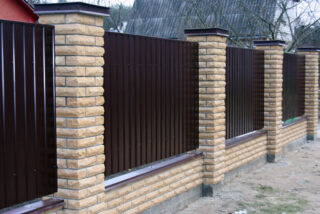
One of the most practical materials is metal profiled sheet.It is recommended when creating a building envelope along the road, to ensure safety and shelter the yard from prying eyes. For construction, a metal profile of any brand is suitable, but the best option for a combination of price and quality is wall sheeting S-8-S-21. Sheets are produced with zinc and polymer coating for corrosion protection.
Pros:
- durability - service life 20-30 years;
- good protection from animals, dust and wind;
- a variety of colors and textures of the material;
- affordable cost;
- high speed of construction.
Minuses:
- a blank fence creates a shadow;
- high windage of the profiled sheet.
For construction, metal supports or brick pillars will be required. If the fence is not high, you can do without a foundation. Lags are attached to the supports, on which the corrugated board is fixed with self-tapping screws or rivets. At a height of 2 m, 3 logs are required to stiffen the structure.
Brick fence
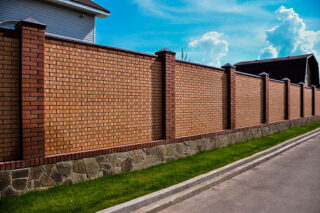
A massive, strong and durable fence, an excellent option for protecting the territory of a private house. Various types of bricks are used in construction: clinker, ordinary ceramic, silicate, hyper-pressed. The aesthetic appeal, durability and strength of the building depend on the choice. Facing products have the best characteristics, they absorb water poorly, and are designed for 50-150 freezing cycles. Ceramic blocks need plastering or stone cladding.
Pros:
- respectable appearance;
- durability;
- reliable protection;
- many decor options due to the variety of facing products;
- the fence does not require maintenance.
Minuses:
- The significant weight of the structure requires a full-fledged foundation, increasing the final estimate.
- It takes a long time to build a brick fence.
- A qualified bricklayer is invited to conduct the masonry.
When choosing a brick as a building material, you need to prepare for significant costs. Before starting work, a full-fledged design of the fence with a soil survey is drawn up. Material consumption depends on the type of masonry - one or two bricks. A good option would be a combination with metal forging.
Plastic fence
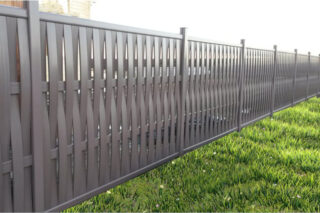
Plastic fences are the best option for dividing areas, zoning the territory. Ready-made sections and elements made of polyvinyl chloride are available, which must be assembled and installed. For the construction of blind fences, vinyl siding is used. Such panels are made with stone, wood, brick decor. Due to its low weight, the fence does not require a foundation.
Polycarbonate designs are popular. The material is monolithic and honeycomb, it differs in the degree of transparency. From the sheets, a fence is obtained that protects against noise, wind, penetration into the site. At the same time, enough light penetrates into the courtyard.
Pros:
- plastic fences are not afraid of moisture, mold or corrosion;
- attractive appearance;
- a variety of decorative solutions;
- ease of installation and maintenance.
Minuses:
- insufficient stiffness of the panels requires the creation of a frame;
- possible burnout under the influence of ultraviolet radiation;
- low scratch resistance.
Plastic fences last no more than 10-15 years. To maintain a neat appearance, they are washed periodically.
Wood fence
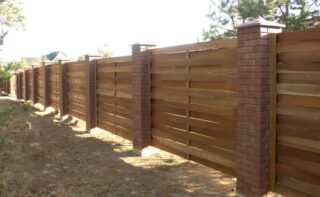
A wooden fence is a classic option. It can be solid (from a board or timber), thinned (picket slats), combined (with supports made of stone, metal). Various lumber is used for installation. Often, leftovers from the construction of a house or a bath are used. It is easy to work with wood, in skilled hands it acquires individuality. The details of the fence are placed horizontally or vertically, the edge of the structure is made even or in the form of a smooth wave.
Material pluses:
- environmental friendliness;
- natural beauty;
- ease of processing;
- affordable cost.
Disadvantages:
- fire hazard;
- the need for the care and protection of wood.
Before construction, parts of the wooden fence must be treated with an antiseptic composition. The solution will protect the wood from rotting, extend the service life. From time to time you will have to update the coating with special impregnations or a coloring agent.
Rabitz
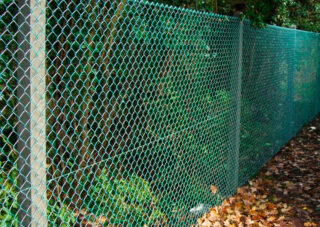
The budget version of the metal fence is used in summer cottages as a temporary or permanent option. The chain-link mesh is made of steel; products without an anti-corrosion coating have a limited service life, but are cheap. They are used to temporarily mark the boundaries of the territory. To extend the durability of the material, it is coated with zinc or a polymer compound.
The mesh is fixed in two ways:
- stretch the canvas and fasten to the posts with clamps, hooks and wire;
- make separate sections in which the chain-link is stretched over the frame, then weld to the posts.
Pros:
- air and light passes without obstacles;
- quick installation;
- affordable cost;
- no care required.
Minuses:
- does not hide the overview;
- is an easily surmountable obstacle.
Planting climbing plants or other hedge options is recommended to improve the appearance of the hedge.
Fences made of stone
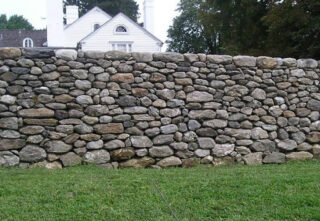
A fence made of various types of stone belongs to heavy structures. It requires project preparation and calculations. The fence needs a high-quality foundation; its service life depends on it. It is recommended to use a strip or pile-grillage base. Sandstone, dolomite, wild stone, limestone, artificial (torn) stone are suitable for the construction of a fence.
Pros:
- high protective function;
- durability;
- individual style;
- Fire safety.
Minuses:
- heavy weight;
- high price;
- the complexity of the construction.
The stone fence can be solid and reach two meters. This option is easier to perform, but it will be expensive due to the high consumption of material. Combined fences look good, in which the stone is laid in the lower part, and the top is built from wood, metal or concrete blocks.
Using several types of material, you can get interesting architectural objects. The supporting pillars of the fence, which take the main load, are made of brick, stone, concrete pillars or profiled pipes. The spans are closed with a metal profile, wood, forged elements or a netting. Such fences are durable, resistant to moisture and frost, they can be matched to any style of the house and site. The most common options are a combination of brick or concrete supports with corrugated board and planks.
What material to make a cheap fence
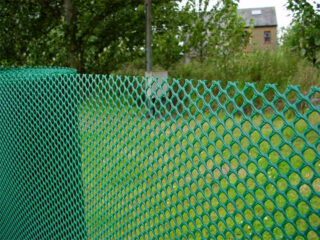
One practical option for inexpensive fencing is to use a protective plastic mesh. The material has many advantages:
- does not rot;
- weighs little;
- has strength;
- painted in various colors.
To build a fence, no special tools are required, pouring the foundation. The mesh is stretched onto the posts made of reinforcement using a steel cable and nylon twine. Construction technology:
- Mark the perimeter, paint the reinforcement to protect it from corrosion.
- The supports are driven into the ground to a depth of 1 m, the span is 2 m.
- Fasten the metal cable to all posts with wire clamps. Stretch the nylon twine in four lines to create a base.
- Throw the mesh over the structure so that the canvas is on both sides, secure with plastic ties at the bottom.
The budget options for fencing include fences made of mesh-netting, unedged boards, sheets of slate, pallets, scrap materials (branches, vines). The choice of material depends on the design requirements.








